
|
|

I
took over this e-zine when Gail, its originator was unable to continue it. With
Gail's permission, I have added her original Rock's of the Week so that everyone
can find the information readily. Please feel free to visit Gail's web site at http://www.davesrockshop.com. |
|
PYRITE / CHALCOPYRITE
Also called "Fool's Gold"
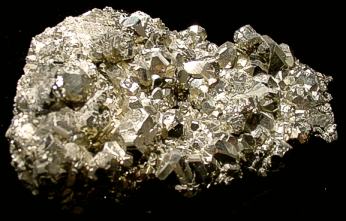
|
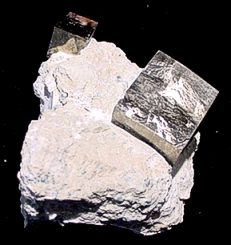
|
|
Scientific:
Pyrite, named for the Greek word for fire "Pyr," as it produces sparks when it is struck with steel. Pyrite has an opaque, shiny, metallic luster and it can be iridescent. The color of pyrite is bright pale yellow to brass-yellow, gray-yellow often tarnished with a brown film of iron oxide. Chalcopyrite can be slightly greenish-yellow because of its copper content. It is often difficult to tell gold from pyrite because they are so similar in appearance. Pyrite may be distinguished from gold by its streak and powder. Pyrite's streak is greenish-black and its powder is black or grayish. Gold streaks gold and its powder is gold. Pyrite is also harder than gold.
It is found in cubes or as pyritohedrons (12 faces each with 5 edges). Sometimes it is pentagonal, dodecahedral or octahedral with parallel striations on the faces. It may be found in massive form or with fine to coarse granular fibrous nodules. Sometimes its crystals are mammillary and rarely it is
stalactitic. |
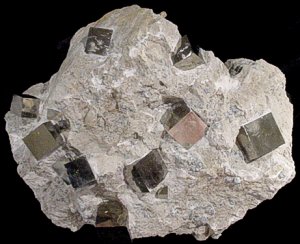
|
|
Pyrite occurs in many different kinds of rocks and in all types of hydrothermal veins. It is associated with quartz, microcline, and biotite in granite pegmatites; regionally found in metamorphic, igneous and sedimentary rocks.
It is found worldwide with large deposits in Italy, France, Spain (famous for it's beautiful single cubes), Peru, Bolivia, Mexico, Romania, Sweden, Norway, Germany, Japan and in the North American states of Arizona, Utah, Colorado, Illinois (famous for disk-like "pyrite suns" found in layers of coal shale), and Pennsylvania.
The value is extremely low and often mistaken for marcasite. Pyrite has had commercial importance as a source of sulfur. It is used in the manufacture of sulfuric acid. Iron may also be produced as a by-product.
Pyrite is insoluble in hydrochloric acid. When powdered it will dissolve in nitric acid.
|
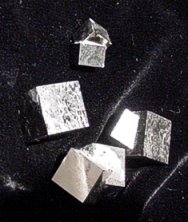
|
Pyrite is the major cause of "Acid rain." When coal-containing pyrite is burned, sulfuric acid is formed by oxidation.
Stone used for building must be free of pyrite because in weathering, pyrite deteriorates and would release corrosive iron sulfates that discolor and destroy stone. |
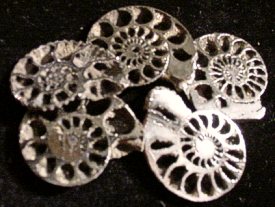
|
|
Hardness: Pyrite 6 - 6.5
Chalcopyrite 3.5 - 4
Chemical Composition: Pyrite: FeS2 Iron Disulfide, often with substantial amounts of nickel and cobalt.
Chalcopyrite contains copper, hence CuFeS2 (Copper Iron Disulfide) |
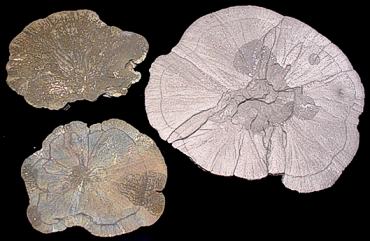
|
|
History:
Pyrite has been used for ornamental pieces and in jewelry for thousands of years. Examples from the ancient civilizations of the Greeks, Romans and Incas have been found.
The Incas in South America used large slabs of polished pyrite as magnificent mirrors. The opposite side was strongly convex. These mirrors were sometimes used for divination. Mirrors like these are still used by crystal mystics to awaken psychic impulses.
Pyrite is sometimes used as amulets by North American Indians. The belief in its magic power is attested by its presence in the outfits and miscellaneous objects, which the medicine men use in the course of their incantations.
The ancient Chinese earth symbol, a golden cube, was said to have been derived from pyrite. |
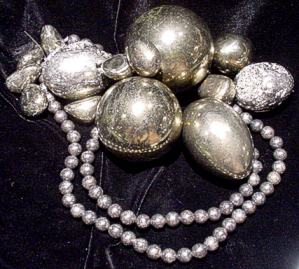
|
Metaphysical:
Pyrite has been used to foster intelligence, promote mental stability, logic, and analytical ability. It has been said to encourage cleverness and creativity.
Possessing this stone is said to encourage communication between the conscious and subconscious mind. Pyrite has been used to promote psychic development, improve memory, practicality, optimism, and strength of will. It has been used to aid in channeling abilities, learning and perception.
It is also said to open the channels between the left and right hemispheres of the brain. This would allow us to tap into and perhaps unfold and use our unique talents and abilities. |
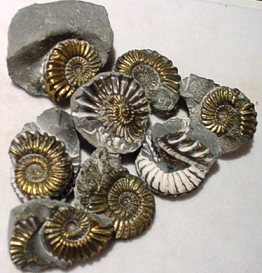
|
|
Chalcopyrite is also said to enhance feelings of self worth, confidence and belief in ones self. When given as a gift it can help the recipient feel useful, worthwhile and powerful. It can boost self-esteem and increases positive self-regard. However, take care when giving any form of pyrite to your granny because it seems to encourage eccentricity, enabling one to feel eccentric and comfortable with their eccentricity.
Pyrite helps one match frequencies with others of higher or lower frequencies. It can help bring members of one's support circle into ones life and makes it easier to feel comfortable with them. It can automatically ease the process of relating most effectively with the friends and associates in each lifetime.
Pyrite possesses a reflective quality that will shield one from many forms of negative energy. Having a piece of pyrite brings protection to the physical, etheric, and emotional bodies.
It can help to keep out pollutants by creating an energy field. It can act as a protector when performing dangerous work. |
|











